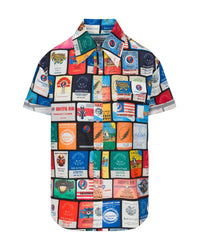Steal Your Face

The "Steal Your Face" logo is one of the most iconic symbols associated with the Grateful Dead. The design features an encircled skull with a 13 point lightning bolt through it, usually depicted in red, white and blue.
The origin of the "Stealie" can be traced back to the band's early days in the 1960s Bay Area when they were developing their visual identity. The logo was created by artist and illustrator Owsley "Bear" Stanley, who was a sound engineer and a key figure in the band's early history. He was known for his psychedelic artwork and was heavily involved in the countercultural scene surrounding the band and 1960's "hippy" scene in and around Haight Ashbery in San Francisco.
The image was first used as a symbol for the Grateful Dead's live shows, particularly during the 1974 Wall of Sound concerts, and it quickly became associated with the band's fans, known as "Dead Heads." The logo captures the spirit of the band's music and the culture surrounding it, combining elements of psychedelic art and the themes of life, death, and rebirth that are prevalent in their songs.
The logo has since been embraced by fans and has become a significant part of the Grateful Dead's legacy, appearing on t-shirts, album covers, and in various forms of art and merchandise related to the band. It symbolizes not just the Grateful Dead but also the community and experience of being part of their music and culture.
Dancing Bears

The "Dancing Bears" logo is another iconic symbol associated with the Grateful Dead and its extensive fanbase. The design features a series of cartoonish, colorful bears dancing in various poses.
The origins of the Dancing Bears date back to the late 1960s and were created by artist Bob Thomas. These bears were inspired by the "Bear on a Unicycle" character that was used as a mascot for the Grateful Dead's early merchandise, particularly t-shirts and other paraphernalia. The bears were also influenced by the countercultural movement of the time, which embraced themes of peace, love, and free expression.
The Dancing Bears were first introduced to the public in the late 1970s. They became particularly popular in the early 1980s when the Grateful Dead's live concerts began to feature these colorful beings prominently in their promotional materials and merchandise. Each bear is designed with its own personality, often with different colors and movement styles, further emphasizing the themes of individuality and freedom.
The Dancing Bears symbolize the joyful and communal spirit of the Grateful Dead's music and their fan culture, known as "Dead Head" culture. Just like the music, the bears represent a sense of unity, celebration, and the importance of connecting with others through art and music. Today, they remain one of the most recognized and beloved symbols associated with the Grateful Dead and continue to be used in various forms of clothing, art, merchandise, and memorabilia.
Bertha


Uncle Sam Skeleton
Gary Gutierrez designed the Uncle Sam Skeleton for 1977's "The Grateful Dead Movie". Based on their song "U.S. Blues", it featured in the movie's animated opening segment. The 1980 Radio City Music Hall poster designed by Dennis Larkins and Peter Barsotti is one of the most famous to feature this skeleton. He also made his way onto the Dead Set Album cover looking out at both San Francisco and Manhattan as a clever play on the cities in where the live record was recorded. Uncle Sam has remained a part of Grateful Dead art and as recently as summer 2024, played a feature role in the graphics at Sphere in Las Vegas where Dead & Company played 30 shows between May and August.
The Iconography Today

Rising to stardom during the ’60s and ’70s, the Grateful Dead came around at a time when all eyes were on the United States, and all of the United States was being transformed by movements emerging out of California. These were the decades when visual representations of culture first gained traction in modern Western culture—and, like Disney’s pink elephants, the Grateful Dead was at the right place, at the right time. But perhaps the ultimate reason why the Grateful Dead and their visual language has endured is the reciprocity between the band, the images and the cultural movements within which they were embedded. The Dancing Bears encapsulated the psychedelic movement, the psychedelic movement largely orbited around the Grateful Dead, fashion and streetwear, always on the hunt for obscure reference points, immersed themselves in the world of psychedelia, and so on. Now, like so many icons that emerged before, these images are part of our shared language, becoming floating signifiers, elusive images that scarcely retain association with the worlds from which they emanated, copies of copies of copies that we all somehow know, even if we don’t know how. And given the fact that the band’s still going with more fans being born every day and more T-shirts being tie-dyed, it’s unlikely to stop any time soon.




